OFF-STAGE SLIDESHOW
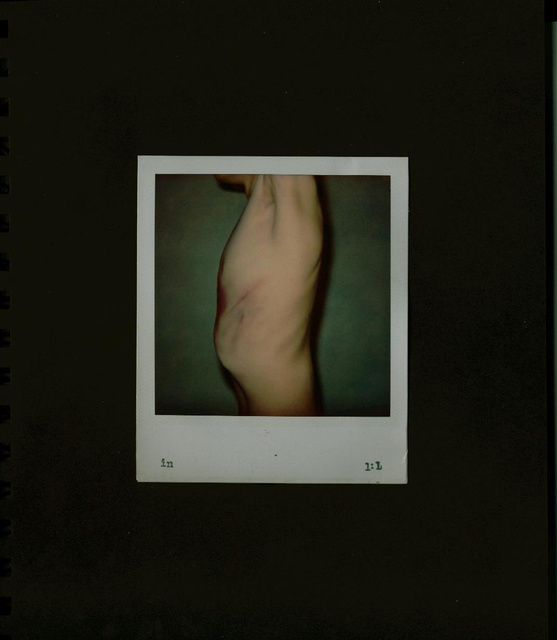
1:1 in/cum/image/shame. scrotum cut-off torso directly above nipples cut-off upper thighs optiderm above suspensor. All acts of violence have been performed offstage.
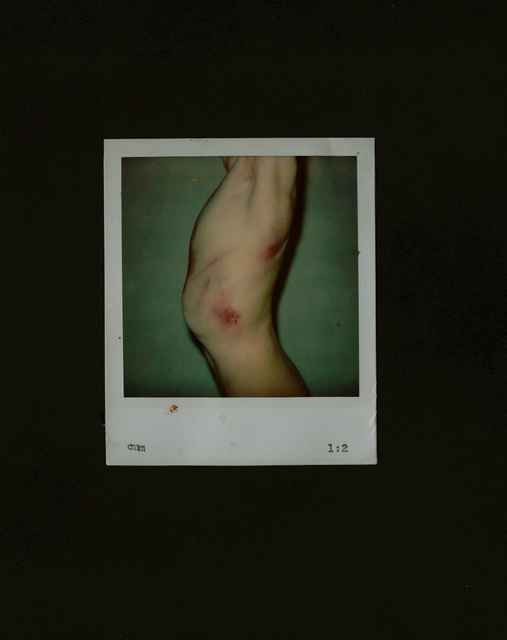
1:2 Joel Black – The Aesthetic of Murder: The aesthetic or theatrical violence of cathartic or transcendent killings has institutional parallels in very different cultures, from the mass murderer’s last stand, to the mayhem of American street-gangs, to the ritual suicides of the warrior class in Japan. For all their cultural diversity, these violent forms of death are similar in that they are characterized by a certain artistry on the part the murderer or suicide. What Leyton says of the mass murderer Mark Essex can be said of the fictional character Hedda Gabler and of the writer-suicide Yukio Mishima: they “stage” their own violent ends in such a way that their deaths assume an artistic form and become an artistic gesture.
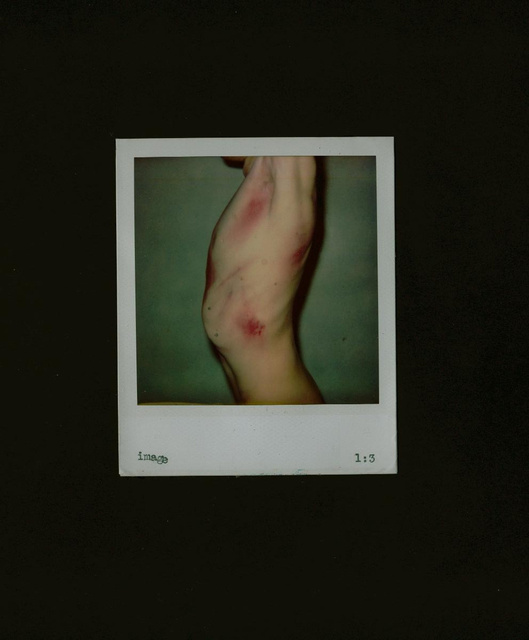
1:3 Jenny Murphy – Art Therapy with Young Survivors of Sexual Abuse: As we would have anticipated, Sally and Sonia were confident in expressing anger towards their abusers and the desire to punish them. I feel it is so important for these children to express symbolically the abusive feelings aroused in them, so that there is less chance of perpetuating the cycle of abuse. We know how many sexually abused boys go on to enact their abusive feelings by becoming perpetrators and how other survivors of abuse re-abuse by harming themselves. I think it is an important part of our groups to allow a different expression of abusive feelings and in this session, Sonia and Sally did pictures that were very punishing and used strong language which would have been unacceptable elsewhere. They continued their abuse by cutting up the clay models of their abusers and disposing them.
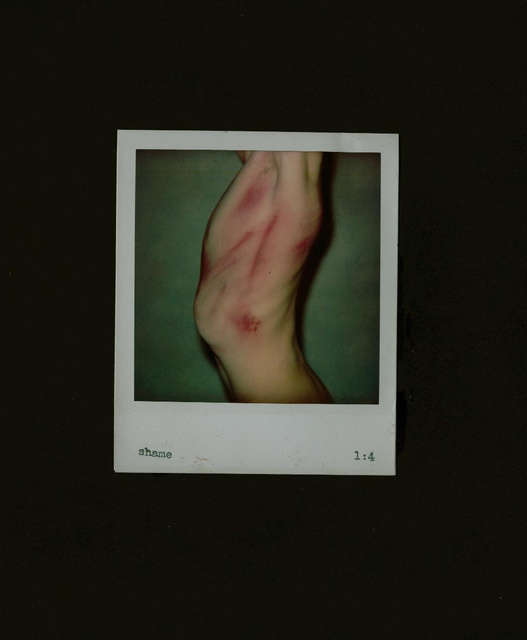
1:4 Diana Milia – Self-Mutilation and Art Therapy; Violent Creation: Despite the degree of morbidity involved in self-mutilation, there does appear to be present an active urge towards separation and change that is not apparent in the use of the fetish. Like the sado-masochistic behaviour that is confined to sexual practices, fetishistic behaviour is not usually ego- dystonic. That is, the behaviour is incorporated and accepted into the personality, and does not interfere with functioning in other areas of life. It is in fact a compromise a compromise that fulfils its function smoothly and continuously. However, as has been discussed, the self- mutilating person is often concerned with personality change, and with taking control over his or her body. While the self may be split between victim and aggressor identities, there is an attempt to move from a passive to an active position, such as in the “identification with the aggressor”. Taking control by the self, even in rudimenentary and impulsive forms, is a manifestation of an attempt at separation and individuation.
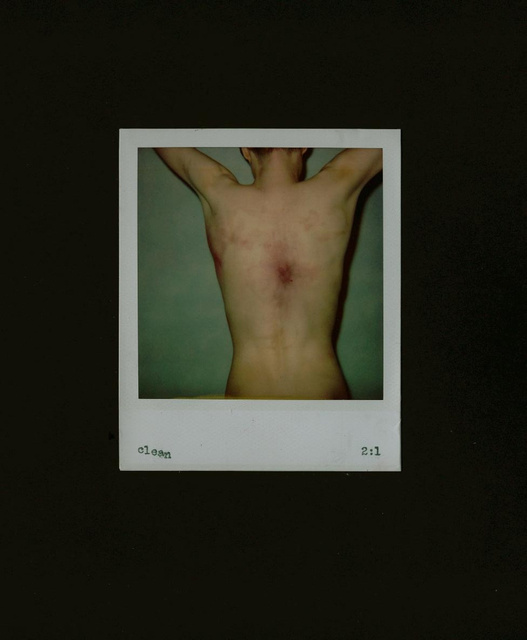
2:1 clean/wound/off/stage. front torso cut-off arms cut-off throat waist cut-off. All acts of violence have been performed offstage.
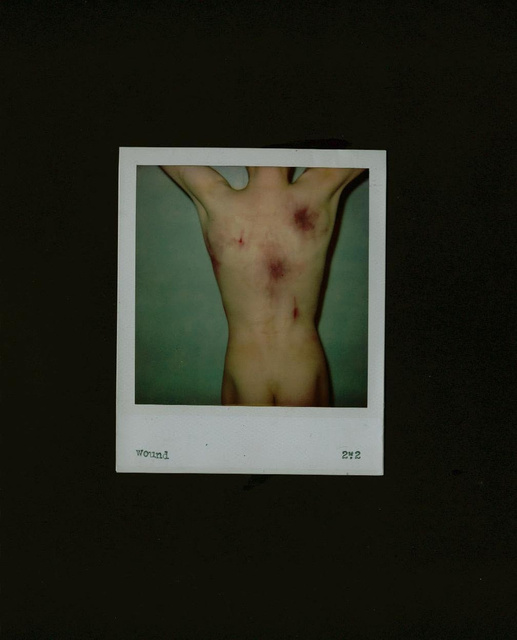
2:2 Sarah Kane – quoted in Graham Saunders’ Love me or kill me; Sarah Kane and the theatre of extremes: I’ve only ever written to escape hell – and it’s never worked – but at the other end of it when you sit there and watch something and think that’s the most perfect expression of the hell that I felt then maybe it was worth it.
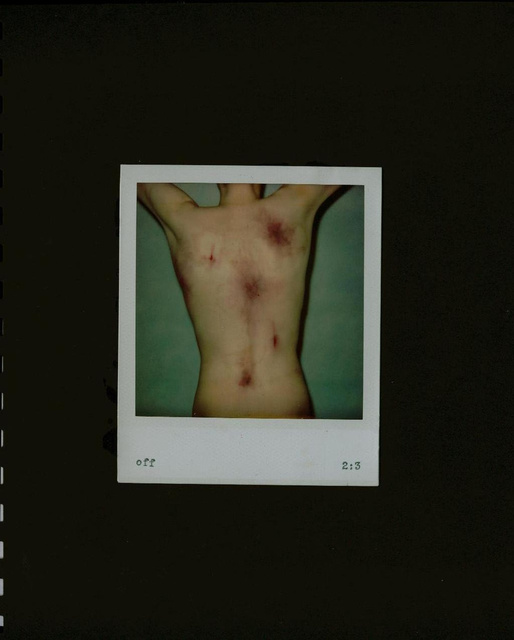
2:3 Gottfried Richter – The Isenheim Altar; Suffering and Salvation in the Art of Grünewald: Then, furthermore, there is this Crucified One. With gruesome realism the painter has depicted him so tortured. Who had ever dared to do that before! This broken body, wounded by innumerable thorns, the hands spread out in agony, the feet swelling round the wounds of the nails, the lips swollen from feverish thirst, the convulsion of the whole body, the pallor already turning into greenish putrefaction – this whole horror of torture and death. Utterly realistic. But quite unrealistic is this Crucified One in proportion to the others: he is drawn much too large.
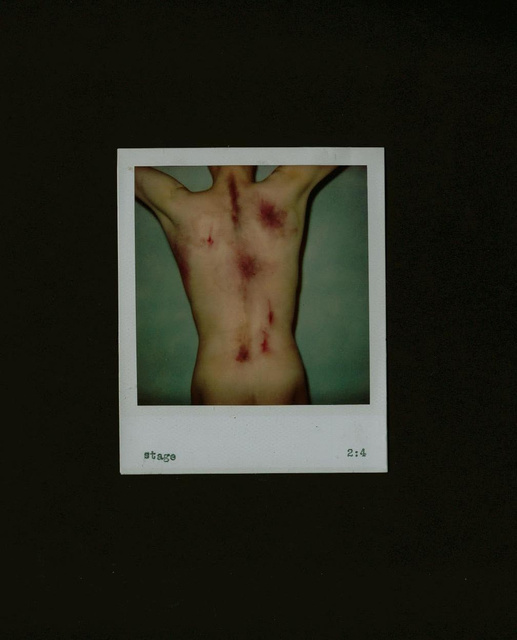
2:4 “Andrew” quoted in Marilee Strong – A Bright Reed Scream; self-mutilation and the language of pain: You’d been working all day, wanted to go out and relax, enjoy yourself. No one around. Went to the liquor store, bought something to drink, sat in your room, listening to your favourite violent and depressive music. Something is welling up inside you, you notice. It feels like at any minute you’re going to explode. Your eyes become watery, you start crying. The crying becomes shouts, yells, screams. You try and hold yourself down. Start kicking the door. Throw staff across the room, out the window. You can’t calm down. You don’t even know what got you into this state in the first place. You dig your nails into the skin on your wrist. Can’t feel anything. It’s like you’re watching a film of someone, this isn’t you. You take your shirt off, look in the mirror. Hate, disgust, frustration, anger, regret. Almost like a ritual, without even thinking what you’re doing, you pick up the razor blade … blood dripping down. Rub in some antiseptic, do it again, do it until you’re calm, you’re satisfied. Like when you go out for a drink and have one or two and just want more, and you know it’s stupid but you just can’t help yourself. How do you feel? Alive. Real. Numb. Calm. Satisfied. You smear the blood around. It’s sick, but the blood feels real, feels human, feels good! At the same time, you feel the pain, you deserve the pain. You tell some people. They say you’re manipulative, attention seeking, you believe it. Only serves to make you feel worse. Some people think you’re sick, you’re weird. One or two may understand, but they’re wary, still shocked by it. Some think you’re suicidal. You’re not.
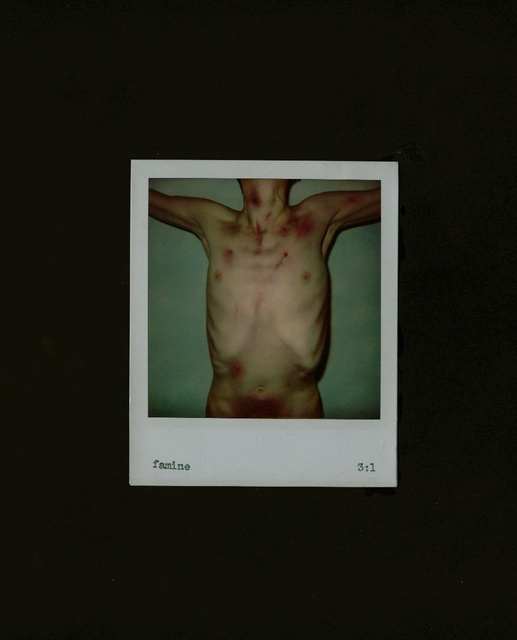
3:1 famine/force/blind/birth. torso cut-off at throat cut-off at hips arms raised out-from body (Y) expose ribs left-side. All acts of violence have been performed offstage.
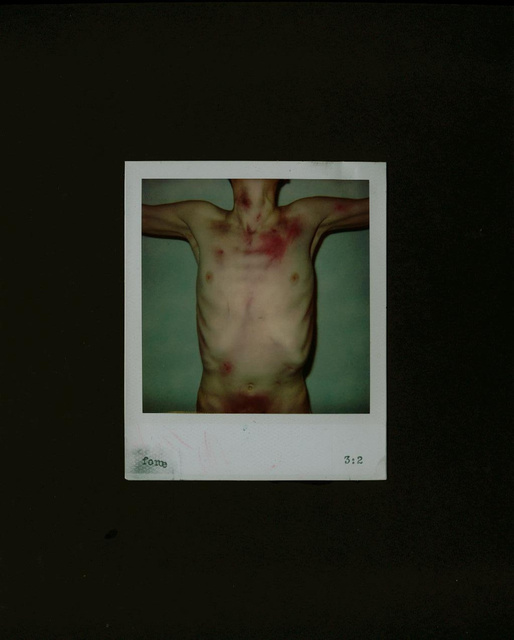
3:2 Yukio Mishima – Confessions of a Mask: There, in my murder theatre, young Roman gladiators offered up their lives for my amusement; and all the deaths that took place there not only had to overflow with blood but also had to be performed with all due ceremony. I delighted in all forms of capital punishment and all implements of execution. But I would allow no torture devices nor gallows, as they would not have provided a spectacle of outpouring blood. Nor did I like explosive weapons, such as pistols or guns. So far as possible I chose primitive and savage weapons-arrows, daggers, spears. And in order to prolong the agony, it was the belly that must be aimed at. The sacrificial victim must send up long-drawn- out, mournful, pathetic cries, making the hearer feel the unutterable loneliness of existence. Thereupon my joy of life, blazing up from some secret place deep within me, would finally give its own shout of exultation, answering the victim cry for cry. Was this not exactly similar to the joy ancient man found in the hunt?
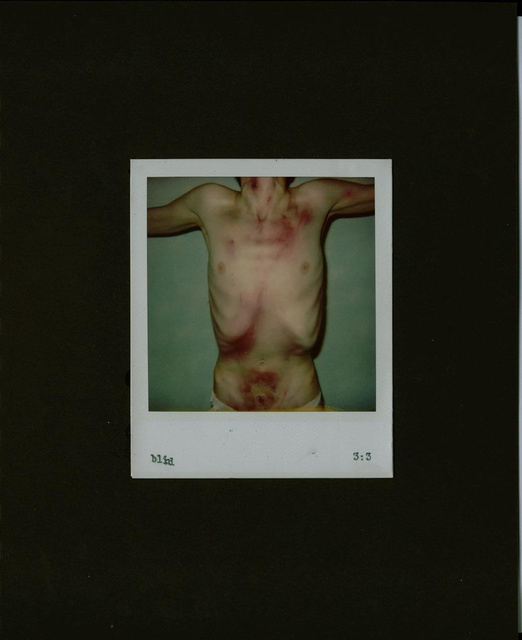
3:3 David Nebreda quoted in an interview with Virgine Luc: Violence does not need any explanation or justification; it is an inevitable cultural argument. The human measure is something insufficient, violent, and always insufficiently violent; with a single nuance, silence and reduction to myself. I think that is how you became intelligent. Discipline is intelligent, thought from hatred is a mature, fertile and discreet activity; in a state of isolation that ends in injuries or death, violence is only the trap of a forgotten language. Unfortunately I have known different forms of tranquillity and we could talk about the extreme violence of tranquillity. At all events, discourse about violence is one thing; human blood or fear is quite another, and yet another in the end is our own blood and our own fear. Violence has only one interlocutor and one pupil. It is a practice, a discourse, immediately, wretchedly close.
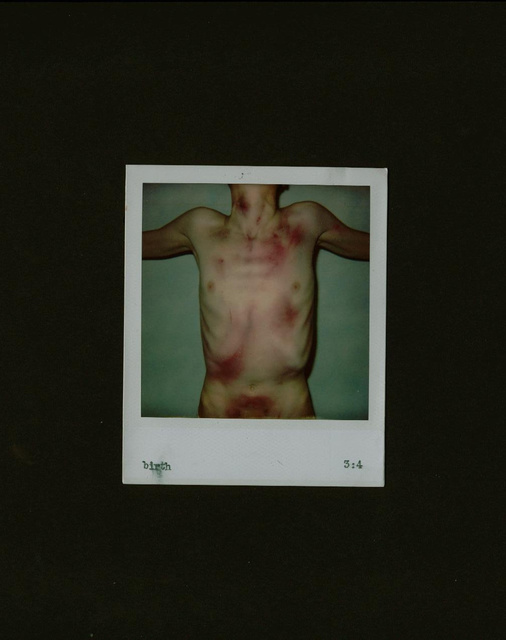
3:4 “Pascal’s” quoted in Michel Dorais – Don’t Tell, The Sexual Abuse of Boys: I must admit I’ve had fantasies about younger boys also. At a certain point I had a dream: I was abusing a young fellow the way I was abused. That’s really not my thing. I reacted badly. It was as though I’d been hit on the head with a sledgehammer. I thought of killing myself. I cut my veins. But I stopped in time. This went on for about eight or nine months. I said to myself: If I’m capable of doing it in a dream I could do it awake. But I don’t want to be involved with young boys. I’m in therapy for that. I try not to think of the past. It’s like putting on a suit of armour. I’ve had other similar dreams recently, with girls in the dreams too. I wake up and feel excited. But now, instead of panicking, I try to make connections. I ask myself what happened the day before to make me think of that. I keep a journal to help me understand, to make connections between it all.
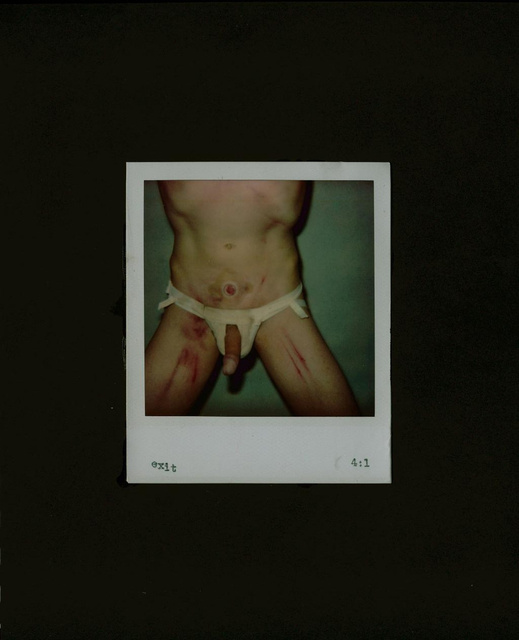
exit/mark/cut/out. back cut-off neck cut-off small-of-the-back arms raised out-from body (Y). All acts of violence have been performed offstage.
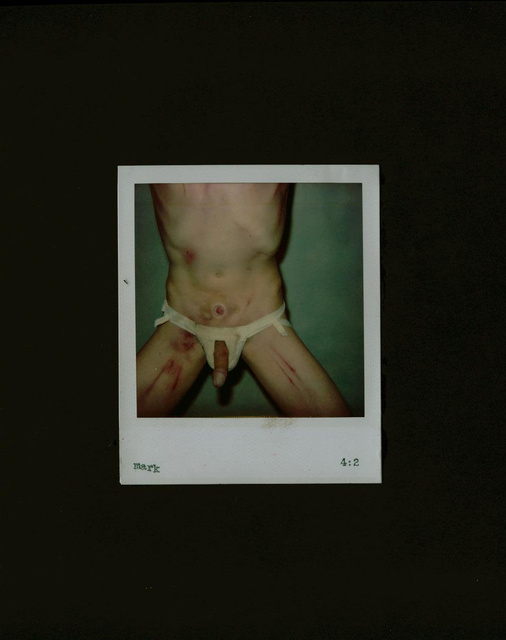
4:2 Antonin Artaud – The Theatre of Cruelty; first manifesto: The theatre cannot become itself again – that is, it cannot constitute a means of true illusion – until it provides the spectator with truthful precipitates of dreams, in which his taste for crime, his erotic obsessions, his savagery, his fantasies, his utopian sense of life and of things, even his cannibalism, pour out on a level that is not counterfeit and illusory but internal.
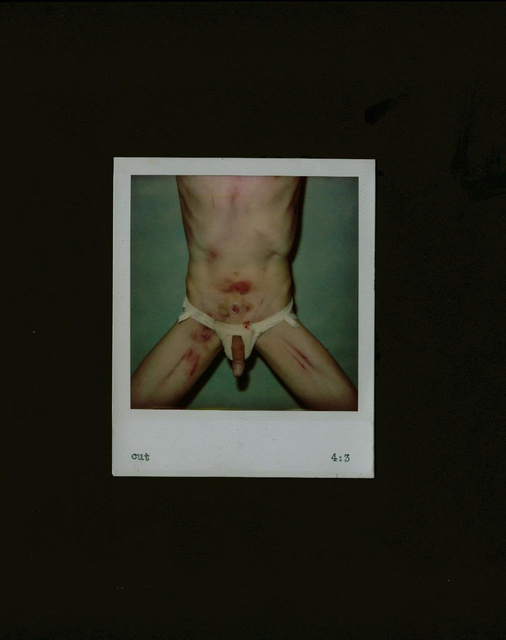
4:3 Robert Hughes – The Fall and Decline of the Avant-garde (Times Magazine, Dec 18 1972): Those interested in the fate of the avant-garde should reflect on a Viennese artist named Rudolf Schwarzkogler. His achievement (and limited though it may be, it cannot be taken from him; he died, a martyr to his art, in 1969 at the age of 29) was to become the Vincent Van Gogh of body art. As every moviegoer knows, Van Gogh once cut off his ear and presented it to a whore. Schwarzkogler seem to have deduced that what really counts is not the application of paint, but the removal of surplus flesh. So, he proceeded, inch by inch, to amputate his own penis, while a photographer recorded the act as an art event. In 1972, the resulting prints were reverently exhibited in that biennial motor show of Western art, Documenta V at Kassel. Successive acts of self-amputation finally did Schwarzkogler in. That the man was clearly mad as a hatter, sick beyond rebuke, is not though important: wasn’t Van Gogh crazy to? But Schwarzkogler’s gesture has a certain emblematic value. Having nothing to say and nowhere to go but further out, he lopped himself and called it art. The politics of experience give way to the poetics of impotence. Farwell Jasper, hullo Rudolf!
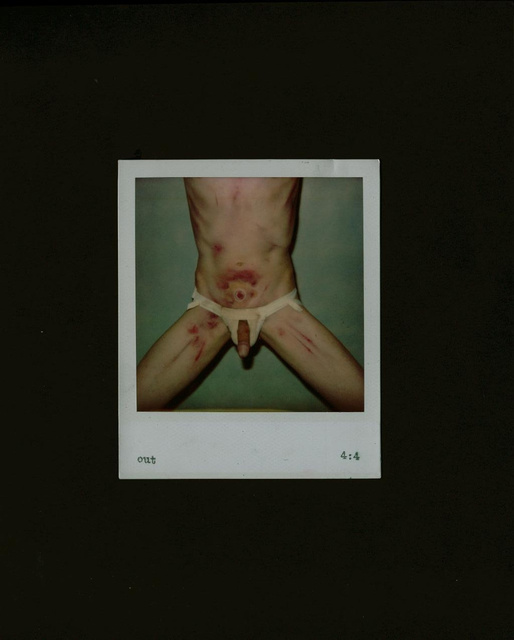
4:4 Peter Kürten qouted in Karl Berg’s The Sadist: You have asked me when I first detected in myself a tendency to cruelty. Well, that goes back decades. When I was a child I did not torture animals, at least, not more than other boys do. Of course we went birds-nesting and caught frogs. But I was prematurely developed sexually and at the age of fifteen or sixteen I was already like that, then I used to stab sheep, for instance, that grazing on the Grafenberger meadows. When I did that I realised that it gave me an agreeable feeling, but without ejaculation. That was the start of it all, and the first time that I became conscious of the connection between cruelty and the sexual urge. I had also at that time cut off the head of a dog. Then I realised that there was something nice in it. You could imagine that, professor, and you must try it for yourself sometime – how the blood rushes absolutely silently when you cut off the head of a goose.